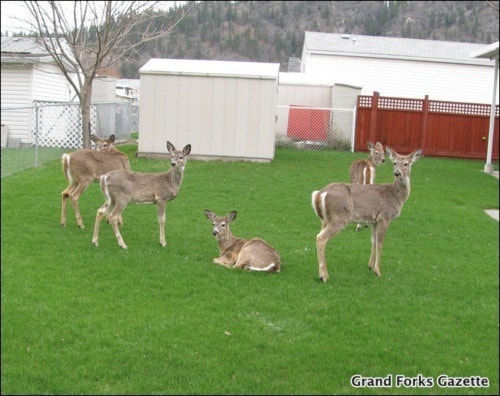The Grand Forks Wildlife Association is concerned about the declining population of deer and elk in the wild.
In order to try and restore the habitat of wild ungulates (hoofed animals), the association is working on a slashing and burning project to inhibit the encroachment of forests into the grasslands.
“Many years ago, you used to be able to drive through (the North Fork) and be able to count thousands of mule deer on the south facing slopes from Christina Lake to Rock Creek,” said Brian Hancock, president of the Grand Forks Wildlife Association. “Now you would be hard pressed to count 100.”
In order to preserve some of the remaining grasslands, the wildlife association has put in over 100 man-hours, cutting back small trees and brush in the Volcanic Creek area.
The group met again on April 20 and the work is all part of a larger wildlife project, organized by Lisa Tedesco, habitat biologist with the Ministry of Forests, Lands and Natural Resource Operations through the Habitat Conservation Trust Foundation.
“Tedesco put in an application for the funding and as part of that application, we committed to do a bunch of volunteer hours,” said Jamie Hibberson, Grand Forks Wildlife Association secretary.
Similar projects around the Boundary are taking place said Hibberson. “The idea is that some of these areas would be prepared for prescribed burning with the goal of opening the area up and reclaiming some of the grasslands that are important for wildlife,” he added.
Tedesco said that the slashing improves the quality and availability of forage for the deer.
“A lot of (shrubs) have grown so tall that they can’t actually reach the new shoots or they aren’t even putting out any new shoots, so there is not a whole lot of nutritional value there,” she said.
Wildfire suppression has also been successful since the association started working in the area last year, said Hancock.
He added that a lot of people in town think there is an overpopulation of deer.
“What we have in town, as we see it, its not wildlife, they are habituated deer, white-tailed deer that have for generations known nothing other than to live in town on peoples lawns,” said Hancock. “What we have in town is absolutely in no way indicative of what is actually out there for wildlife as far as wild deer on the mountain.”
Hancock estimates that the wildlife association has already cut and cleared half a dozen hectares.
